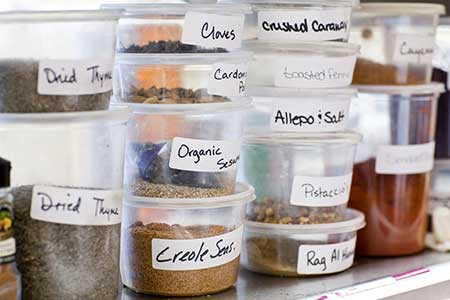 One common misconception about emergency preparedness is that food storage quality doesn’t matter as long as you have some food stored that will last for a long time without spoiling. Having something stored is better than nothing but it is also crucial to fill your body with nourishing ingredients during an emergency. This will keep you satisfied and in top form. Eating lesser-quality foods can leave you susceptible to sickness and diminish your mental and physical health. You are storing food to protect your family against starvation but you also want to protect them from sickness and diseases caused by harmful ingredients. Do this by knowing what goes into the food that you buy.
One common misconception about emergency preparedness is that food storage quality doesn’t matter as long as you have some food stored that will last for a long time without spoiling. Having something stored is better than nothing but it is also crucial to fill your body with nourishing ingredients during an emergency. This will keep you satisfied and in top form. Eating lesser-quality foods can leave you susceptible to sickness and diminish your mental and physical health. You are storing food to protect your family against starvation but you also want to protect them from sickness and diseases caused by harmful ingredients. Do this by knowing what goes into the food that you buy.
Long-term emergency food storage is made to last a long time. Some companies in the industry cut corners and add a variety of artificial preservatives, dyes and flavors in order to lengthen the shelf life of their foods. If you are committing to protect your family be sure to make the best, healthiest choices possible. When selecting your food storage beware of artificial ingredients. Here are other red flags to consider as you look around.
Avoid Hydrolyzed Yeast Extract and Similar Flavorings

Fresh Ingredients are more flavorful
Hydrolyzed yeast extract is a controversial ingredient found in many packaged foods and is common in food storage items. It is primarily used as a flavor-enhancer and is created by breaking down yeast cells. The FDA classifies yeast extract as a natural ingredient but according to many health experts, yeast extract is a cheaper alternative to monosodium glutamate (MSG) and actually does contain some MSG.(1) Some health and consumer advocates say that labeling something as containing yeast extract is the way food companies avoid saying that a product contains MSG.(2)
MSG has many negative side effects. Consumption of MSG has been linked to a variety of scary conditions including headaches, numbness in the face and neck, heart palpitations, chest pain, nausea, weakness, appetite control problems and other negative symptoms.(1) Whether or not you have had a sensitivity to MSG in the past, it is best to avoid this ingredient in your storage food altogether.
For a good list of other additives that are linked to MSG check out the following article:
“Hidden Sources of MSG.” Truth in Labeling. Truth in Labeling Campaign
Consider GMO-Free Foods
When looking for emergency food it is equally important that the ingredients are free from genetically modified organisms or labeled GMO-free. The use of genetically modified foods is another controversial topic in the world of food and nutrition. It is best to avoid GMOs while the debate is still going on, particularly if this is a long-term purchase.
Genetically modified organisms are created by taking the genetic material of one organism and inserting it into the genetic code of another. This bold practice is becoming more and more widespread despite being widely acknowledged as a risky and understudied process. Many experts opposed to genetically modified foods argue that there has not been adequate testing on human subjects. Despite the increasing insertion of GMO ingredients into mainstream foods there are still too many unknowns about the health effects these human-engineered foods could have. Some health groups like the Center for Food Safety have gone so far as to claim that genetically modified foods can increase the likelihood of antibiotic resistance, immune-suppression and even cancer.(3) Why put your family at risk with untested ingredients when you will have other worries to contend with in a survival situation?
Because the use of GMOs in manufactured foods is becoming such a widespread practice, very few emergency foods are free of GMO ingredients. However, there are a few companies that produce foods that are GMO-free. If this is an issue that is important to you, be certain that the emergency food is certified GMO-free. Some companies may claim to be free of genetically modified ingredients but without the certification have no proof.
Other Health Considerations
Other health considerations include checking amounts of cholesterol, trans fat and sodium in the food storage. Packaged foods often have high amounts of these three things and emergency foods are no exception. High-quality emergency food brands limit cholesterol, trans fat, and sodium amounts but you need to read the labels to be sure.
Make Sure Your Food Storage Ingredients Will Stand The Test Of Time
Emergency food should be able to last and still be healthful. As you look for the right emergency food be aware that some food storage companies haven’t done their research on ingredients that spoil versus those that keep. As a result they incorporate ingredients into their emergency food that go bad after a relatively short period of time. Canola oil, for example, will only last a year before it goes rancid, thus spoiling whatever food storage in which it is used. Novice food companies use canola oil in their granola to make the clusters stick together and uneducated food buyers end up with a worthless product after just a year.
Bottom line: it’s important to know what goes into your storage food. Take the time to do some research on the food you are buying; be sure it will contribute to the health and well-being of you and your family in a disaster.
Taste Matters

Taste Matters
You have made your checklist, done the research and narrowed down your options; now it comes down to taste and appeal.
Emergency-preparedness gurus often publish lists of specific items you need to store for an emergency. One popular guideline suggests something like this: for a year’s worth of food storage each person needs 350 pounds of grain, 75 lbs of milk, 65 lbs of sugar, etc. These types of specific food guidelines can be a helpful starting point but one size does not fit all. That guideline is useless for people who have food sensitivities such as gluten or dairy intolerance. Review the first chapter of this guide and consider what is best for your family.
Regardless if you choose canned, bulk or long-term storage foods, the most important principal we stress is to store the food that your family eats the most. Having food routines that carry over from your life before will make the hard adjustments easier in a disaster situation. Buying things you don’t regularly eat just for added variety on the shelf may sound like a good idea. Unfortunately these will likely be the last foods you reach for and if not regularly rotated could be expired, possibly ending up not usable at all.
Do you remember going to dinner at a friend’s house as a kid? Even if it was a close friend everything about the dinner seemed foreign to you from the way they folded their napkins to the saltiness of their gravy. Even the smell of their cooking was different from the dinnertime smells in your kitchen at home. Little differences like this mattered and affected your comfort level. Eating food from different cultures can sometimes put us in this situation, too. Routines, especially involving food, can be powerful in an emergency situation. Food affects the way we feel. If unfamiliar, food can make a scary situation that much worse.
Many food storage suppliers offer entrée options that are familiar favorites like macaroni and cheese, enchiladas and various soups. Look around at all available options and make selections based on what your family eats on a regular basis.
Store Food that Tastes Good

Store Food that Tastes Good
At first glance taste might not seem like a very important factor when purchasing emergency food. It’s easy to justify buying food that you don’t normally eat and telling yourself, “It will be an emergency. Whether I like the food I’m eating or not will be the least of my worries.” However, making sure your food storage is appealing and tastes good to you and your family is more important than it initially seems. Having food that’s delicious and comforting, especially in an emergency situation, will bring peace of mind. Another good thing about having food storage you like is knowing that your family will eat it and it won’t go to waste.
If you have kids, buying good-tasting food is even more important. Kids are picky eaters. If it is hard to get your child to eat during a regular night at the dinner table, think of the desperation you will feel trying to get your child to eat in an emergency situation. This is not just about preferences, either. In emergency situations kids have a particularly hard time forcing themselves to eat, especially if the food is unfamiliar. On the other hand, if the food is something your child loves, it will really help.
Food that is familiar and tastes good has the power to make us feel relaxed, comfortable and cared for, even in stressful situations. Ideally, you would occasionally replace your regular meal with something from your storage food so that your family gets used to eating it.
Sample your Options
Since long-term food storage is made by others it is important to sample before buying. Never make a food storage purchase without first sampling one product from each of the companies you have narrowed down. Most food storage companies have small sample packs of their larger food kits available that are fairly inexpensive. Test a few and choose the ones that most suit your family’s tastes. This not only gives you an idea as to how the food will taste, but you will see what is involved in the preparation.
When ordering a sample ask the company if the food they are sending to you is the same as what is in the larger packages. Sometimes companies send out higher quality food in their sample packages to trick buyers into thinking that their food is better than it really is.
Variety is Optimal
When building your food supply, make sure to include a variety of all types of food storage. No one wants to be stuck eating canned beans for six months. Eating the same foods for a long period of time can also leave you deficient in the vitamins and minerals you normally get from a wider variety of foods..
Start collecting different entrée options and then add in “good” calorie side dishes for variety. You can also expand your food storage assortment by purchasing more canned goods, bulk items and other supplementing items. A wide food variety is enjoyable and will also provide options should you develop an intolerance to a particular food.
Dietary Needs
If you or a family member has special dietary needs, some food storage companies offer gluten-free, dairy-free and vegetarian options. You want to store food similar to what you regularly eat that has already been adapted to your needs.
Plan on Extra Water
When purchasing items for your storage plan consider your additional water needs. Unlike canned food, bulk foods need water for recipes and preparation; freeze-dried and dehydrated food also need water for reconstitution. We take for granted that every day we have water immediately on hand. Figuring out how much water you use every day and calculating how much you need to store for food preparation can become overwhelming. Water storage takes up a lot of space and is hard to accomplish. Your best option is to first store what you can. We recommend that you also invest in a quality water filter and locate an alternate water source.
Don’t Forget the Treats
The idea of storing a few luxury items that you are used to having and would not like to do without is commonly overlooked. These items might be coffee, chocolate or other specialty foods that are part of your routine. Having luxury items may seem trivial but a simple treat or comfort snack will be invaluable in a survival situation. Not only will it be good for morale, you could use it as a bartering tool should the situation come to that. Having treats stored for an emergency benefits everyone.
Pet Considerations
For people with pets it is a common practice to store several months’ worth of food at a time in case of emergency. Because dry pet food can go rancid relatively quickly it’s a good idea to continually rotate through your stock. Canned pet food can last as long as regular canned foods but is typically pricier than dry pet food.
Dry pet food is a good option and can be purchased in larger quantities. This pet food contains fats and oils and will spoil if not stored correctly. Dry food stored in large plastic, glass or metal bins can help protect the food against insects but exposure to light, air, humidity and heat speeds up the rate at which the food degrades. The fats and oils can stick to the bottom and sides of the container leaving a film that can become rancid over time. This further contaminates other bags of food added to it and could lead to a health risk for your animal.
It is best to wash and dry the container thoroughly prior to adding new food. You could also keep the dry food in its original packaging when placing it in one of these containers. Make sure to get the air out of the bag after each use and seal with a good lid. If these dry foods are unopened or stored well the shelf life can be up to one year. Always check the “best buy date” for your particular brand. The recommended “use by” date for an open package is six weeks. If you repackage this food into food grade buckets and add oxygen absorbers you may increase this to up to 2 years, depending on the food. Further measures must be taken to avoid spoilage for longer storage.
Legacy Premium is proud to introduce the first healthy, well-balanced dog or cat food storage with a 10-year shelf life. Our pet food storage is stored in heavy-duty Mylar pouches complete with oxygen absorbers; pouches are stored in stack-able, waterproof and rodent-proof plastic buckets that are re-sealable and BPA-free.
Food storage can be a big purchase so take the time to figure out what foods you and your whole family will want to eat. An emergency is not the time to try new foods, nor is it the time to force your family to eat food they do not like. Food should be a comfort rather than a negative factor adding to the stress of a bad situation. Hopefully this is food insurance that you never have to use but if you do, you want it to be good, healthy food that is enjoyable to eat.
